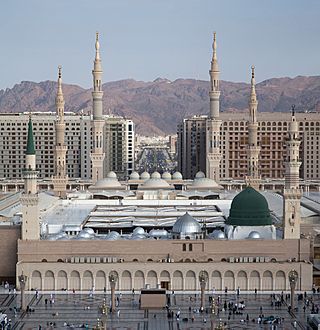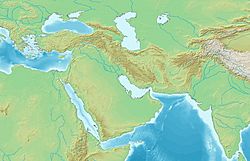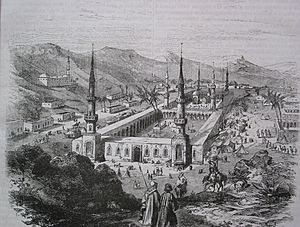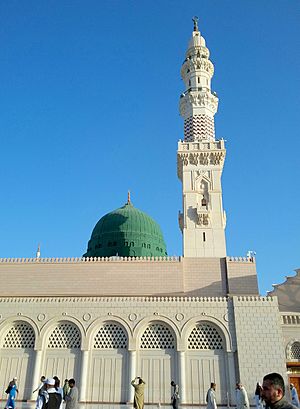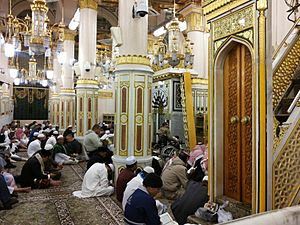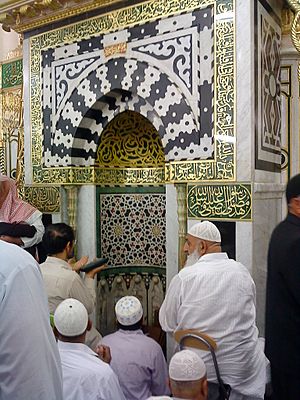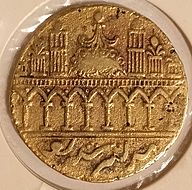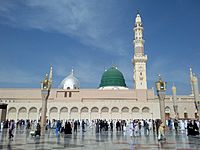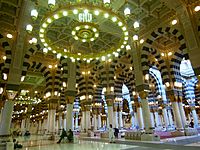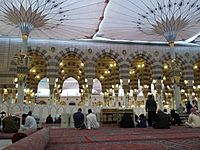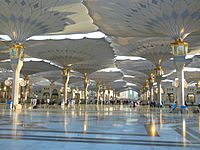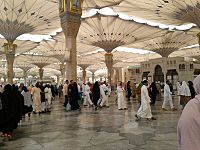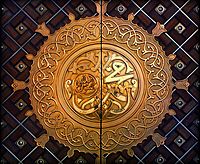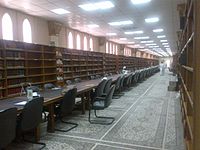Al-Masjid an-Nabawi facts for kids
Quick facts for kids The Prophet's Mosque |
|
|---|---|
|
Al-Masjid An-Nabawī (ٱلْمَسْجِد ٱلنَّبَوِي)
|
|
|
A picture of the mosque from the south with the city of Medina in the background
|
|
| Religion | |
| Affiliation | Islam |
| Rite | Ziyarah |
| Leadership |
|
| Location | |
| Location | Al-Haram, Al-Medinah 42311, Al-Hejaz |
| Country | |
| Administration | The Agency of the General Presidency for the Affairs of the Two Holy Mosques |
| Architecture | |
| Architectural type | Religious architecture |
| Architectural style | Islamic architecture |
| Founder | Muhammad |
| Date established | 623 CE (1 AH) |
| Specifications | |
| Capacity | 1,000,000 |
| Minaret(s) | 10 |
| Minaret height | 105 m (344 ft) |
| Inscriptions | Verses from the Quran and the names of Allah and Muhammad |
The Prophet's Mosque, known in Arabic as Al-Masjid an-Nabawī (meaning "mosque of the Prophet"), is a very important mosque in Islam. It was the second mosque ever built by the Islamic prophet Muhammad in Medina, after the Quba Mosque. It is also the second largest and holiest site in Islam, after the Masjid al-Haram in Mecca.
This special mosque is in the center of Medina, Saudi Arabia. Many people visit it as part of their pilgrimage. Prophet Muhammad himself helped build the mosque. The land belonged to two young orphans, Sahl and Suhayl. They wanted to give the land as a gift to Muhammad, but he insisted on paying for it because they were orphans. Abu Ayyub al-Ansari paid the price, becoming the donor of the mosque. He also hosted Muhammad when he first arrived in Medina in 622 CE.
At first, the mosque was an open-air building. It was used as a community center, a court, and a religious school. It had a raised platform called a minbar where people taught the Quran and where Muhammad gave sermons. Over time, different Islamic rulers made the mosque much bigger and more beautiful. They even named parts of it after themselves and their families. After a big expansion, the mosque became the final resting place of Muhammad and the first two leaders of Islam, Abu Bakr and Umar ibn Al-Khattab. A famous part of the mosque is the Green Dome, which covers Muhammad's tomb. Many pilgrims who visit Mecca for the Hajj also come to Medina to see the Green Dome.
In 1909, during the time of the Ottoman Empire, the Prophet's Mosque was the first place in the Arabian Peninsula to get electrical lights. For centuries, the mosque was guarded by eunuchs. Today, it is usually open all the time. It was only closed to visitors once in recent times, during the COVID-19 pandemic in 2020.
History of the Prophet's Mosque
Building the First Mosque (622–660 CE)

Prophet Muhammad built the mosque in 622 CE after he arrived in Medina. He bought the land, which was a burial ground, from two orphans. Abu Ayyub al-Ansari paid for the land. It took seven months to build the first mosque.
The first mosque was about 30.5 by 35.62 meters. Its roof was made of palm trunks and leaves, about 3.60 meters high. It had three doors: the Gate of Mercy, the Gate of Gabriel, and the Gate of the Women. At first, the prayer direction (qiblah) faced north towards Jerusalem. Later, it was changed to face the Kaaba in Mecca.
- Under Abu Bakr: The mosque stayed the same during the rule of Abu Bakr.
- Under Umar: The next leader, Umar, made the mosque bigger. He removed houses around it, except for those of Muhammad's wives. The mosque became about 57.49 by 66.14 meters. The walls were made of sun-dried mud bricks, and the roof was raised to 5.6 meters. Umar also added three more gates.
- Under Uthman: In 649 CE, Uthman, the third leader, rebuilt the mosque. It became a rectangular shape, facing the Kaaba. It measured about 81.40 by 62.58 meters. Stone columns replaced the palm trunks, and teakwood was used for the ceiling.
Later Islamic Rulers (660–1517 CE)
- Umayyad Expansion (706–707 CE): The Umayyad leader Al-Walid I ordered a huge expansion of the mosque. This work took three years. Materials came from the Byzantine Empire, and skilled workers from Greece and Egypt helped. The mosque grew from 5,094 square meters to 8,672 square meters. This expansion included the graves of Muhammad, Abu Bakr, and Umar. For the first time, minarets (towers for calling to prayer) were built around the mosque.
- Abbasid and Mamluk Periods: The Abbasid leader Al-Mahdi made the mosque even bigger to the north. Later, the Mamluk Sultan Baibars rebuilt parts of the mosque, including the areas around the tombs. Another Mamluk Sultan, Al-Ashraf Qansuh al-Ghuri, built a stone dome over his own grave in 1476.
Ottoman Period (1517–1919 CE)
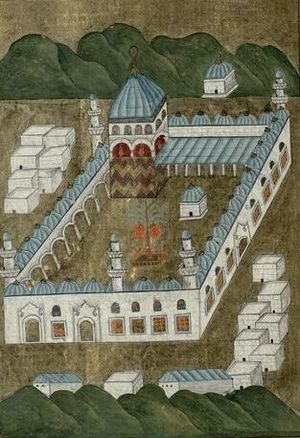
The Ottoman sultans also made many changes to the mosque.
- Suleiman the Magnificent (1520-1566): Sultan Suleiman the Magnificent rebuilt the east and west walls. He added a new minaret and placed a new steel-covered dome on Muhammad's tomb. He also wrote the names of Ottoman sultans on the walls.
- Murad III (1574-1595): The minbar (pulpit) used today was built during his rule.
- Mahmud II (1808-1839): Sultan Mahmud II finished building "the Purified Residence" on the southeast side. This area was covered with a new dome. In 1837, the dome was painted green and became known as the "Green Dome".
- Abdulmecid I (1839-1861): Sultan Abdülmecid I spent thirteen years rebuilding the mosque, starting in 1849. Red stone bricks were used. The mosque's floor area increased by 1,293 square meters. The entire mosque was rebuilt, except for Muhammad's tomb and a few other parts. Verses from the Quran were written on the walls. A school for teaching the Quran was built, and a place for washing (ablution) was added. The prayer area was doubled in width and covered with small domes. A fifth minaret was also built.
Changes During Saudi Rule (1805–1811 CE)
When Saud bin Abdul-Aziz took Medina in 1805, his followers, the Wahhabis, removed nearly every tomb and dome in Medina. They did this to prevent people from worshiping these places, as they believed it went against their teachings. However, the Green Dome was kept. Muhammad's tomb had its gold and jewel decorations removed, but the dome itself was not destroyed.
Modern Saudi Rule (1925–present CE)
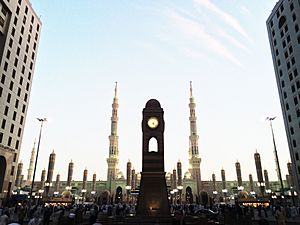
After the Kingdom of Saudi Arabia was founded in 1932, the mosque had several major changes.
- King Abdulaziz (1932–1953): In 1951, King Abdulaziz ordered parts of the mosque to be taken down to build new sections. Older columns were made stronger with concrete and copper. Two minarets were replaced, and two new ones were added. A library was built to hold old Qurans and religious books.
- King Faisal (1974): King Faisal added 40,440 square meters to the mosque.
- King Fahd (1985): The mosque was expanded again during King Fahd's rule in 1985. Buildings around the mosque were removed. By 1992, the mosque covered 160,000 square meters. Escalators and 27 courtyards were added.
- Recent Expansion (2012–present): In 2012, a huge project worth $6 billion was announced to make the mosque even bigger. Once finished, it should hold between 1.6 million to 2 million worshipers.
Architecture of the Mosque

The modern mosque is a large, rectangular building with two stories. The oldest part, the Ottoman prayer hall, is towards the south. It has a flat roof with 27 sliding domes. When the domes are closed, holes in their bases let light into the mosque. The sliding roof closes during afternoon prayers to keep visitors cool. When the domes slide open, they create light wells for the prayer hall. The courtyards also have large umbrellas that open to provide shade. These sliding domes and retractable umbrellas were designed by architect Mahmoud Bodo Rasch.
The Green Dome
The chamber next to the Rawdah holds the tombs of Prophet Muhammad and two of his close companions and fathers-in-law, Abu Bakr and Umar. There is also a space reserved for Jesus, as Muslims believe he will return and be buried there. This area is covered by the famous Green Dome. It was built in 1817 CE and painted green in 1837 CE.
The Rawdah
Ar-Rawḍah ash-Sharīfah means "The Noble Garden." It is a special area between the minbar (pulpit) and Muhammad's burial chamber. Muslims believe it is one of the "Gardens of Paradise." This area used to be marked by a green carpet, different from the red carpet in the rest of the mosque, but now the whole mosque uses green carpets. Prophet Muhammad said about visiting him:
- "Whoever visits me after my death is like he who had visited me during my life."
- "When a person stands at my grave reciting blessings on me, I hear it; and whoever calls for blessings on me in any other place, his every need in this world and in the hereafter is fulfilled and on the day of Qiyamah I shall be his witness and intercessor."
Mihrabs (Prayer Niches)
The mosque has two mihrabs, which are niches that show the direction of prayer (qiblah). One was built by Muhammad, and a larger one was built by Uthman. Uthman's mihrab is the one used for daily prayers, while Muhammad's mihrab is kept as a reminder. There are also other niches, like the Miḥrāb Fāṭimah, which Muhammad built for late-night prayers.
Minbars (Pulpits)
The first minbar used by Muhammad was a simple block of date palm wood. He later replaced it with one made of tamarisk wood, about 50 by 125 centimeters. In 629 CE, three steps were added to it. The first two leaders, Abu Bakr and Umar, did not use the third step out of respect for Muhammad. Uthman added a fabric dome over it. The minbar was replaced several times by different rulers. The marble minbar built by the Ottoman sultan Murad III in 1590 is still used in the mosque today.
Minarets (Towers)
The first four minarets (towers from which the call to prayer is made) were built by Umar and were about 26 feet high. In 1307, a minaret called Bāb as-Salām (Gate of Peace) was added. After a big renovation project in 1994, the mosque now has ten minarets, each about 104 meters high. The minarets have different shapes: cylindrical at the top, octagonal in the middle, and square at the bottom.
Gallery
- Pictures related to al-Masjid an-Nabawi
-
An 18th century bronze token showing the original Mamluk era dome, where the Green Dome is now.
-
The mosque on the back of a 1993 100-Saudi riyal paper bill. The Masjid an-Nabawi is on all 100-riyal notes in Saudi Arabia, with the Green Dome on the front.
-
The mosque's library has many old manuscripts and books, focusing on Islamic history.
See also
 In Spanish: Mezquita del Profeta para niños
In Spanish: Mezquita del Profeta para niños
- Destruction of early Islamic heritage sites in Saudi Arabia
- History of medieval Arabic and Western European domes
- Holiest sites in Shia Islam
- Holiest sites in Sunni Islam
- Islamic art
- List of burial places of founders of religious traditions
- List of mosques
- Lists of mosques


